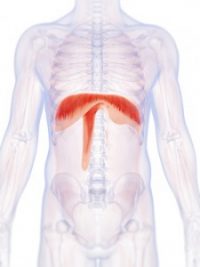
WHAT IS PHRENIC NERVE PACING?
Phrenic nerve pacing, also known as diaphragm pacing, is the sending of electric impulses to the diaphragm, resulting in respiration for otherwise ventilator dependent patients. Phrenic nerve pacing with the Avery Diaphragm Pacing System typically benefits clients due to:
- Increased mobility
- Lower infection rates
- Increased ease of eating and drinking
- Improved speech
- Cost effectiveness
HOW PHRENIC NERVE PACING WORKS
The Avery Mark IV Diaphragm Pacing System System consists of electrodes sutured to the phrenic nerves and an external transmitter/antenna assembly. The device applies repetitive stimulus patterns to the phrenic nerves, which causes smooth, rhythmic contractions of the diaphragm, resulting in the inhalation of air into the lungs.
The external transmitter and antenna send energy and stimulus information to the passive receiver implant. The receiver translates radio waves into stimulating pulses that are delivered to the phrenic nerve by the electrode. The diaphragm muscle contracts and produces the inhalation phase of breathing. The transmitter then stops generating signals, which allows the diaphragm to relax, and exhalation occurs. This cycle of signal followed by no signal is repeated automatically by the transmitter to produce a normal breathing pattern.
THE AVERY DIAPHRAGM PACING SYSTEM SYSTEM
The Avery Diaphragm Pacing System System is the only diaphragm-pacing system with full pre-market approval from the USFDA and CE marking privileges under the European Active Implantable Medical Device Directive for both adult and pediatric use. In addition, its system of using small implanted radiofrequency receivers rather than electrode wires that pass directly through the skin may decrease a patient’s risk of infection and ongoing wound care management issues.



